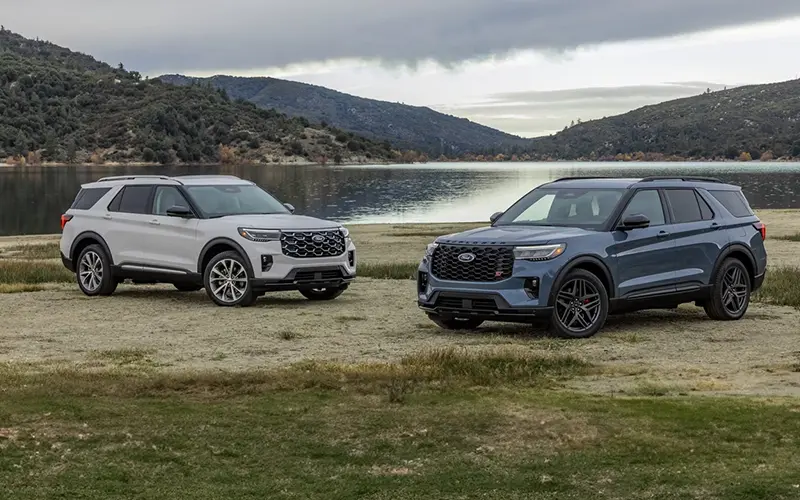2025 Ford Explorer vs. the Competition

The Ford Explorer wasn’t the first SUV in the world, but it certainly popularized the vehicle type as a mainstream option. Excellent versatility and car-like handling made the Explorer a hit from the beginning, and it continues this tradition today. But one consequence of popularizing the midsize SUV so much is that the Explorer now has quite a few competitors. How do these competitors measure up? Let’s take a look.
Ford Explorer VS Nissan Murano
| 2025 Ford Explorer Active | VS | 2024 Nissan Murano SV |
| $39,755 | MSRP | $38,740 |
| 300 HP / 310 LB-FT TQ ✓ | Standard Horsepower / Torque | 260 HP / 240 LB-FT TQ |
| 3.0L EcoBoost® V6 ✓ | Available Engine | None |
| Rear-wheel drive ✓ | Drivetrain | Front-wheel drive |
| 10-speed automatic ✓ | Transmission | CVT |
| 5,000 pounds ✓ | Towing Capacity | 1,500 pounds |
| 7 ✓ | Seats | 5 |
| 84.1 cubic feet ✓ | Max Cargo Capacity | 74.4 cubic feet |
| Tri-zone ✓ | Climate Control | Dual-zone |
| 13.2 inches ✓ | Touchscreen Size | 8 inches |
First up we have the Nissan Murano. Which, like the Explorer, was a big hit when it first debuted. But years have gone by, and the Murano hasn’t exactly evolved to keep pace. For example, the Murano is still powered by the same 3.5-liter V6 found under its hood more than 20 years ago, and in that time its power output has only gone from 245 horsepower to 260 horsepower. The Explorer has embraced turbocharging, and the result is that the Explorer is both more powerful and more fuel efficient. And if you want more power, Ford offers a twin-turbo V6 that pushes horsepower to 400, while there is no optional engine for the Murano.
Both SUVs have the option of all-wheel drive, but if you don’t opt for it, the Explorer comes with rear-wheel drive, which makes for a more balanced and engaging driving experience than the front-wheel drive Murano. Similarly, the 10-speed automatic in the Explorer is going to feel more engaging as well. But perhaps the bigger advantage of the transmission is that it gives the Explorer a much higher towing capacity, more than triple that of the Murano. You can carry more inside the Explorer as well, be it people or cargo, as the Explorer is notably more spacious. In addition to more space, your passengers will also enjoy a more comfortable temperature, thanks to the tri-zone climate control that comes standard on the Explorer. And lastly, one last sign of how poorly the Murano is keeping up, the 8-inch infotainment touchscreen is practically a relic in today’s market.
Ford Explorer VS Volkswagen Atlas
| |
|
|
| 2025 Ford Explorer Active | VS | 2024 Volkswagen Atlas SE |
| $39,755 | MSRP | $37,995 |
| 300 HP / 310 LB-FT TQ ✓ | Standard Horsepower / Torque | 269 HP / 273 LB-FT TQ |
| 3.0L EcoBoost® V6 ✓ | Available Engine | None |
| Rear-wheel drive ✓ | Drivetrain | Front-wheel drive |
| 10-speed automatic ✓ | Transmission | 8-speed automatic |
| 5,000 pounds ✓ | Towing Capacity | 2,000 pounds, 5,000 available on a higher trim |
| 43 inches / 39 inches ✓ | Legroom (1st row / 2nd row) | 41.7 inches / 37.6 inches |
| 12 speakers ✓ | Premium Stereo | 10 speakers |
| Standard ✓ | Power Liftgate | Optional |
| Standard ✓ | App-Based Remote Start | Optional, subscription-based |
Next up we have the Volkswagen Atlas, a newer nameplate and VW’s SUV flagship. It’s bigger and more modern than the Mureno, but it shares a number of the same drawbacks, less horsepower, a FWD drivetrain, and a less engaging transmission. And although there used to be a V6 option, there isn’t anymore. Of course, that option was still less powerful than the engine in the Explorer, but it was a bit closer than the only option that’s left. The Atlas can have the same towing capacity as the Explorer, but not this price point. That requires you to option up to the next trim up, which adds more than $4,000 to the price.
The Atlas has just over an inch more third-row legroom than the Explorer. But Ford decided to prioritize the rows that people are much more likely to actually use, the first and second. Both of these rows offer a bigger legroom advantage than the third-row advantage in the Atlas as well. Both vehicles come with a six-speaker stereo system, but for audiophiles who are looking to upgrade, the Explorer offers more speakers with its premium system. In addition, you need to upgrade to the top trim of the Atlas before that premium stereo is included, whereas the premium system is standard equipment on all Explorer trim except the base. A power liftgate is something a lot of SUV buyer look for, which is why Ford made it standard equipment, but VW has yet to catch on to this strategy. Lastly, Volkswagen makes you sign up and pay a subscription fee for connected services like app-based remote start or being able to check where you parked. In fairness, that is pretty standard, most companies work this way, but not Ford. And that’s a pretty big plus.
Ford Explorer VS Dodge Durango
| |
|
|
| 2025 Ford Explorer ST | VS | 2024 Dodge Durango R/T |
| $55,505 | MSRP | $51,270 |
| 400 HP / 415 LB-FT TQ ✓ | Horsepower / Torque | 360 HP / 390 LB-FT TQ |
| 10 ✓ | Transmission Speeds | 8 |
| 4,766 pounds ✓ | Curb Weight | 5,179 pounds |
| 18 / 25 / 21 ✓ | Fuel Economy (city / highway / combined) | 14 / 22 / 17 |
| 21-inch ✓ | Wheels | 20-inch |
| 13.2 inches ✓ | Infotainment Touchscreen Size | 10.1 inches |
| Standard ✓ | LED Foglights | Not Available |
| Standard ✓ | Sport Seats | Optional |
| Standard ✓ | Heated 2nd Row Seats | Not Available |
Last up we have the Dodge Durango. Since, as we’ve seen, there aren’t too many mainstream midsize SUVs that make a performance version to compete with the Explorer ST, but since there is one for the Durango, that’s what we’re focusing on. But right from the start, we can see that the ST still has quite a noticeable power advantage. Add to that the more advanced 10-speed transmission and the fact that the Explorer is more than 400 pounds lighter, and it’s clear that you get much more of a performance experience with the Explorer. Even though fuel economy might not be the first priority when people shop for a performance vehicle, the difference here is quite dramatic. This even though the Explorer offers better performance and interior dimensions that are nearly identical.
While the difference in performance is probably more than enough to justify the slight price difference between these two vehicles, there is a difference when it comes to equipment as well. The Explorer has a bigger infotainment touchscreen, bigger wheels, and comes with LED foglights. Seating is definitely another win for the Explorer, with the ST coming with unique sport seats, something reserved for the six-figure limited editions of the Durango. The Explorer ST also comes with heated 2nd-row seats as standard equipment. A symptom of the aging platform underpinning the Durango is that this isn’t even an option.
Winner - Ford Explorer

The Ford Explorer has been a staple of the SUV market for decades with good reason. Through constant evolution and improvement, it sets the bar for the whole segment, no easy task with a segment this size. But the advantages of the Explorer are clear, and Sarchione Ford of Randolph can help you find the one that works best for you.

